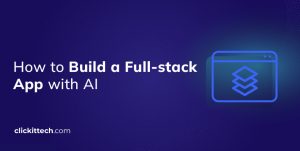Ever wondered how Netflix keeps you glued to your screen with uninterrupted streaming bliss? Netflix’s Architecture is responsible for the smooth streaming experience that attracts viewers worldwide behind the scenes. Netflix’s system architecture emphasizes how important it is to determine how content is shaped in the future. Join me on a journey behind the scenes of Netflix’s streaming universe!
Netflix Architecture Diagram is designed to efficiently and reliably provide content to millions of consumers simultaneously. Given its 270 million+ members across more than 190 countries (as of 2025), the scalability of Netflix’s infrastructure is critical.
So, let me explain Netflix’s Architecture and explain how it continues to shape how we enjoy our favorite shows and movies.
- Understanding the Requirements for System Design
- Netflix Architecture Diagram
- Netflix architecture Embracing a Cloud-Native
- Netflix Architectural Triad
- Client-Side Components
- Netflix Architecture: Backend Infrastructure
- Databases in Netflix Architecture
- Content Processing Pipeline in Netflix Architecture
- Ensuring Seamless Streaming with Netflix’s Canary Model
- Conclusion
- FAQs
It sheds light on how Netflix delivers a flawless streaming experience to millions of customers worldwide. By exploring the nuances of Netflix architecture, we can better learn about the technology and tactics that underlie its success.
Furthermore, Netflix’s design can be used as a blueprint for developing scalable, reliable, and efficient systems. Its design principles and best practices can teach important lessons about building and optimizing complicated distributed systems.
Understanding Netflix’s architecture can also help you recognize the continual innovation driving the development of digital media consumption.
How does the Netflix Architecture Diagram work?
Netflix system Architecture is a complex ecosystem made up of Python and Java with Spring Boot for backend services and Apache Kafka and Flink for data processing and real-time event streaming. Redux, React.js, and HTML5 on the front end provide a captivating user experience.
Numerous databases, including Cassandra, HBase, SimpleDB, MySQL, and Amazon S3, offer real-time analytics and handle enormous volumes of media content. Jenkins and Spinnaker help with continuous integration and deployment, and AWS powers the entire infrastructure with scalability, dependability, and global reach.
Netflix’s dedication to providing flawless entertainment experiences to its vast worldwide audience is demonstrated by the fact that these technologies only make up a small portion of its vast tech stack.
In fact, Netflix has built sophisticated platforms on top of Kafka and Flink to democratize real-time data usage across the company. At the current scale, tens of thousands of Kafka topics and Flink streaming jobs run in production, processing trillions of events and multiple petabytes of data each day.
To handle operational analytics and high-cardinality metrics at this scale, Netflix created and open-sourced Mantis – a real-time stream processing system tailored for cost-effective processing of telemetry data
Additionally, Netflix has adopted newer communication layers such as GraphQL and gRPC to support more efficient, low-latency interactions across microservices (2025 update).
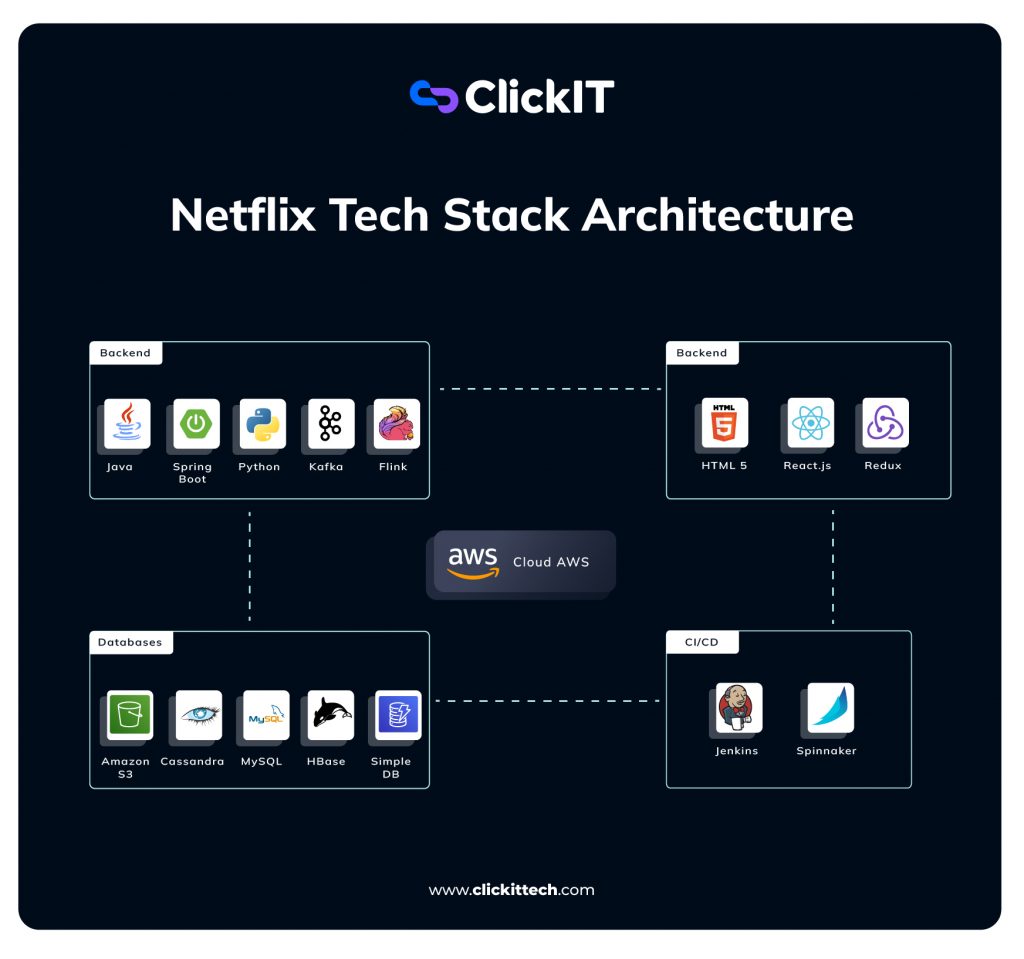
Understanding the Requirements for System Design in an Application
System design is crucial in developing complex software or technological infrastructure. Specifications act as the basis for the entire system, driving choices and forming the end product.
What are the prerequisites for system design, and what makes them crucial?
Functional Requirements
The system’s functional requirements specify the features, functions, and capabilities that it must include. These specifications outline the system’s main objective and detail how various parts or modules interact. Functional requirements for a streaming platform like Netflix, for instance, could encompass the following, including but not limited to:
- Account Creation: Users should be able to create accounts easily, providing the necessary information for registration.
- User Login: Registered users should be able to log in to their accounts securely using authentication credentials.
- Content Suggestion: The platform should offer personalized content suggestions based on user preferences, viewing history, and other relevant data.
- Video Playback Capabilities: Users should be able to stream videos seamlessly, with options for playback controls such as play, pause, rewind, and fast forward.
Non-Functional Requirements
Non-functional requirements define the system’s behavior under different scenarios and ensure that it satisfies specific quality requirements. They cover the system’s performance, scalability, dependability, security, and compliance aspects. Non-functional requirements for a streaming platform like Netflix, for instance, could include but are not limited to:
- Performance Requirements: During periods of high utilization, the system must maintain low latency and high throughput.
- Compliance Requirements: The platform must abide by Data Protection Regulations standards regarding user data protection.
- Scalability Requirements: The infrastructure must be scalable to handle growing user traffic without sacrificing performance.
- Security Requirements: Strong authentication and encryption procedures must be implemented to prevent unwanted access to user information.
- Reliability and Availability Requirements: The system needs to include failover methods and guarantee high uptime for uninterrupted service delivery.
Netflix Architecture: Embracing a Cloud-Native
Netflix started a revolutionary journey by selecting AWS as its cloud provider and moving most of its services to the cloud by 2015. Following seven years of intensive work, the cloud migration was finished in early January 2016, which meant that the streaming service’s last remaining data center components were shut down.
But getting to the cloud wasn’t a simple task. Netflix adopted a cloud-native strategy, completely overhauling its operational model and technological stack. This required embracing NoSQL databases, denormalizing their data model, and moving from a monolithic application to hundreds of microservices.
Changes in culture were also necessary, such as adopting DevOps procedures, continuous delivery, and a self-service engineering environment. Despite the difficulties, this shift has made Netflix a cloud-native business that is well-positioned for future expansion and innovation in the rapidly changing field of online entertainment.
Today, Netflix remains fully committed to AWS’s cloud, leveraging multiple AWS regions for resilience and global reach rather than pursuing a multi-cloud strategy. The company continuously fine-tunes its cloud usage, like optimizing instance types and capacity to handle ever-growing traffic at scale and to capitalize on new AWS capabilities for efficiency.
Netflix Architectural Triad: Client, Backend and CDN
With millions of viewers globally, each component is essential to delivering content.
Client
The client-side architecture lies at the heart of the Netflix experience. This includes the wide range of devices users use to access Netflix, such as computers, smart TVs, and smartphones. Netflix uses a mix of web interfaces and native applications to ensure a consistent user experience across different platforms.
These clients manage playback controls, user interactions, and interface rendering to deliver a unified experience regardless of the device. Thanks to the responsive optimization of the client-side architecture, users may easily browse the extensive content library and enjoy continuous streaming.
Netflix Architecture: Backend
Backend architecture is the backbone of Netflix’s behind-the-scenes operations. A complex network of servers, databases, and microservices manages user accounts, content catalogs, recommendation algorithms, billing systems, and other systems. In addition to handling user data and coordinating content delivery, the backend processes user requests.
Netflix’s backend architecture has changed significantly over time. It moved to cloud infrastructure in 2007 and adopted Spring Boot as its primary Java framework in 2018. When combined with the scalability and dependability provided by AWS, proprietary technologies like Ribbon, Eureka, and Hystrix have effectively coordinated backend operations.
In 2026, Netflix expanded its backend modernization through a zero-configuration service mesh built on Envoy proxies, enabling unified resilience, routing, and observability without application-level libraries. This simplified cross-service communication and allowed Netflix to centralize traffic management more efficiently across its large microservices ecosystem.
The backend also powers Netflix’s personalization. A suite of algorithms determines which movies or shows to recommend to each user.
Starting in 2025, Netflix began merging its recommendation pipelines into a unified multi-task AI foundation model capable of learning shared user preferences from multiple domains (home page rows, search results, artwork ranking). This enabled more cohesive personalization and faster rollout of algorithmic improvements worldwide.
We handle your AWS cloud so you can focus on growing your business. Book a Free Call
Netflix Architecture: Content Delivery Network
A Content Delivery Network (CDN) is a strategically positioned global network of servers that aims to deliver content to users with optimal reliability and minimum delay. Netflix runs a Content Delivery Network (CDN) called Open Connect.
It reduces buffering and ensures smooth playback by caching and serving material from sites closer to users. Even during times of high demand, Netflix reduces congestion and maximizes bandwidth utilization by spreading content over numerous servers across the globe.
This decentralized content delivery method improves global viewers’ watching experiences, lowering buffering times and increasing streaming quality.
Netflix’s CDN software continuously analyzes viewing patterns to optimize what content gets cached on each Open Connect Appliance. Tailored algorithms anticipate user behavior by prefetching and storing shows likely to be played during peak hours, effectively positioning popular content at the network edge.
By proactively distributing content and dynamically fine-tuning caching strategies for each locale, Netflix minimizes latency, lessens backbone traffic, and ensures viewers get quick-loading streams even under heavy demand.
Read our blog CloudFront vs CloudFlare
Client-Side Components
Web Interface
Over the past few years, Netflix’s Web Interface has significantly transformed, switching from Silverlight to HTML5 to stream premium video content. With this change, there would be no need to install and maintain browser plug-ins, which should simplify the user experience.
Netflix has increased its compatibility with a wide range of online browsers and operating systems, including Chrome OS, Chrome, Internet Explorer, Safari, Opera, Firefox, and Edge, since the introduction of HTML5 video.
Netflix’s use of HTML5 extends beyond simple playback. The platform has welcomed HTML5 adoption as an opportunity to support numerous industry standards and technological advancements.
Mobile Applications
Netflix’s mobile applications extend its streaming experience to smartphone and tablet users. These applications guarantee that users can access their favorite material on the road. They are available on multiple platforms, including iOS and Android. By combining native development and platform-specific optimizations, Netflix provides a smooth and user-friendly interface for various mobile devices.
With features like personalized recommendations, seamless playback, and offline downloading, Netflix’s mobile applications meet the changing needs of viewers on the go.
The Netflix mobile app users may enjoy continuously viewing their favorite series and films while driving, traveling, or just lounging around the house. With frequent upgrades and improvements, Netflix is committed to providing a captivating and delightful mobile viewing experience.
Additionally, Netflix’s apps leverage intelligent prefetching to enhance playback continuity. For instance, as a user nears the end of an episode, the app uses machine learning to predict that the next episode will be watched and begins buffering it in the background. This proactive approach minimizes buffering and ensures instant start of the next episode or recommended title, illustrating how Netflix applies AI on the client side to improve user experience.
Smart TV Apps
The Gibbon rendering layer, a JavaScript application for dynamic updates, and a native Software Development Kit (SDK) comprise the complex architecture of the Netflix TV Application. By utilizing React-Gibbon, a customized variant of React, the application guarantees fluid UI rendering and responsiveness across multiple TV platforms.
Prioritizing performance optimization means focusing on frames per second and key input responsiveness. Prop iteration reduction and inline component creation increase rendering efficiency, and style optimization and custom component development further optimize performance.
With a constant focus on enhancing the TV app experience for consumers across many platforms, Netflix cultivates a culture of performance excellence.
Revamping the Playback Experience: A Journey Towards Modernization
In 2025, Netflix rolled out its first AI-assisted UI discovery features, including natural-language search powered by generative AI models. This allowed users to type queries like “fun sci-fi show with mystery vibes,” and the system returned more accurate results based on semantic understanding rather than simple metadata matching.
The team’s three main canvases were Pre Play, Video Playback, and Post Play. Their goal was to increase customer pleasure and engagement. Netflix revolutionized its playback user interface by utilizing technologies like React.js and Redux to expedite development and enhance performance.
Read our success story about How to improve your SaaS application with React Redux
AI-Powered Search and New UI Features (2025 Update)
Netflix introduced conversational search powered by OpenAI-based semantic models, letting users search by tone, mood, or detailed descriptions.
A redesigned AI-personalized homepage dynamically updates “Your Next Watch,” “For You Today,” and trending rows in real time.
A TikTok-style vertical video feed was tested on mobile, using AI to select 5–15 second clips to boost content discovery.
Netflix Architecture: Backend Infrastructure
Content Delivery Network (CDN)
Netflix’s infrastructure depends on its Content Delivery Network (CDN), also called Netflix Open Connect, which allows content to be quickly delivered to millions of viewers globally. Globally distributed, the CDN is essential to ensuring that customers in various locations receive high-quality streaming content.
Netflix Open Connect CDN works because servers, called Open Connect Appliances (OCAs), are positioned strategically near Internet service providers (ISPs) and their users. When content delivery is at its peak, this proximity reduces latency and guarantees effective performance. Netflix can maximize bandwidth utilization and lessen its dependence on costly backbone capacity by pre-positioning content within ISP networks, improving the total streaming experience.
Scalability is one of Netflix’s CDN’s primary features. With OCAs installed in about 1,000 locations across the globe, including isolated locales like islands and the Amazon rainforest, Netflix can meet the expanding demand for streaming services across a wide range of geographic areas.
Additionally, Netflix grants OCAs to qualified ISPs so they can offer Netflix content straight from their networks. This strategy guarantees improved streaming for subscribers while saving ISPs’ running expenses. Netflix cultivates a win-win relationship with ISPs by providing localized content distribution and collaborating with them, enhancing the entire streaming ecosystem.
Transforming Video Processing: The Microservices Revolution at Netflix
By implementing microservices, Netflix has transformed its video processing pipeline, enabling unmatched scalability and flexibility to satisfy the needs of studio operations and member streaming. The switch to the microservices-based platform from the monolithic platform brought a new age of agility and feature development velocity.
Each step of the video processing workflow is represented by a separate microservice, allowing for simplified orchestration and decoupled functionality. Microservices have produced noticeable results by facilitating quick iteration and adaptation to shifting business requirements.
To manage this explosion of services, Netflix built its container management platform called Titus, which provides scalable and reliable Docker container execution on AWS. Titus enables Netflix to launch and run over three million containers per week across seven regional stacks, powering everything from streaming backend services to batch analytics and machine learning jobs.
By orchestrating microservices in containers, Netflix achieves efficient resource utilization and consistent deployments at massive scale.
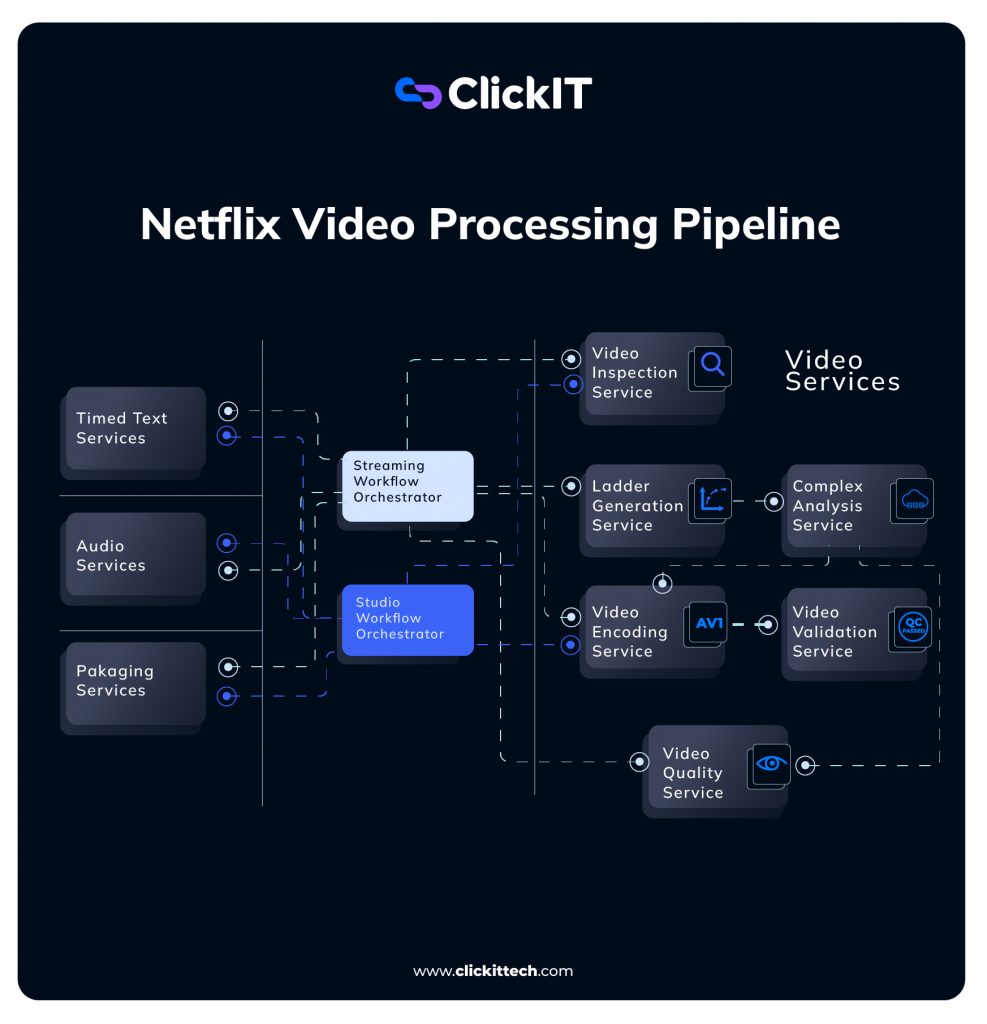
Playback Process in Netflix Open Connect
Thanks to Netflix Open Connect’s playback procedure, customers can enjoy a flawless and excellent viewing experience worldwide. It functions as follows:
- Health Reporting: Open Connect Appliances (OCAs) report to the cache control services in Amazon Web Services (AWS) on a regular basis regarding their learned routes, content availability, and overall health.
- User Request: From the Netflix application hosted on AWS, a user on a client device requests that a TV show or movie be played back.
- Authorization and File Selection: After verifying user authorization and licensing, the AWS playback application services choose the precise files needed to process the playback request.
- Steering Service: The AWS steering service chooses which OCAs to serve files from based on the data that the cache control service has saved. The playback application services receive these OCAs from it when it constructs their URLs.
- Content Delivery: On the client device, the playback application services send the URLs of the relevant OCAs. When the requested files are sent to the client device over HTTP/HTTPS, the chosen OCA starts serving them.
Below is a visual representation demonstrating the playback process:
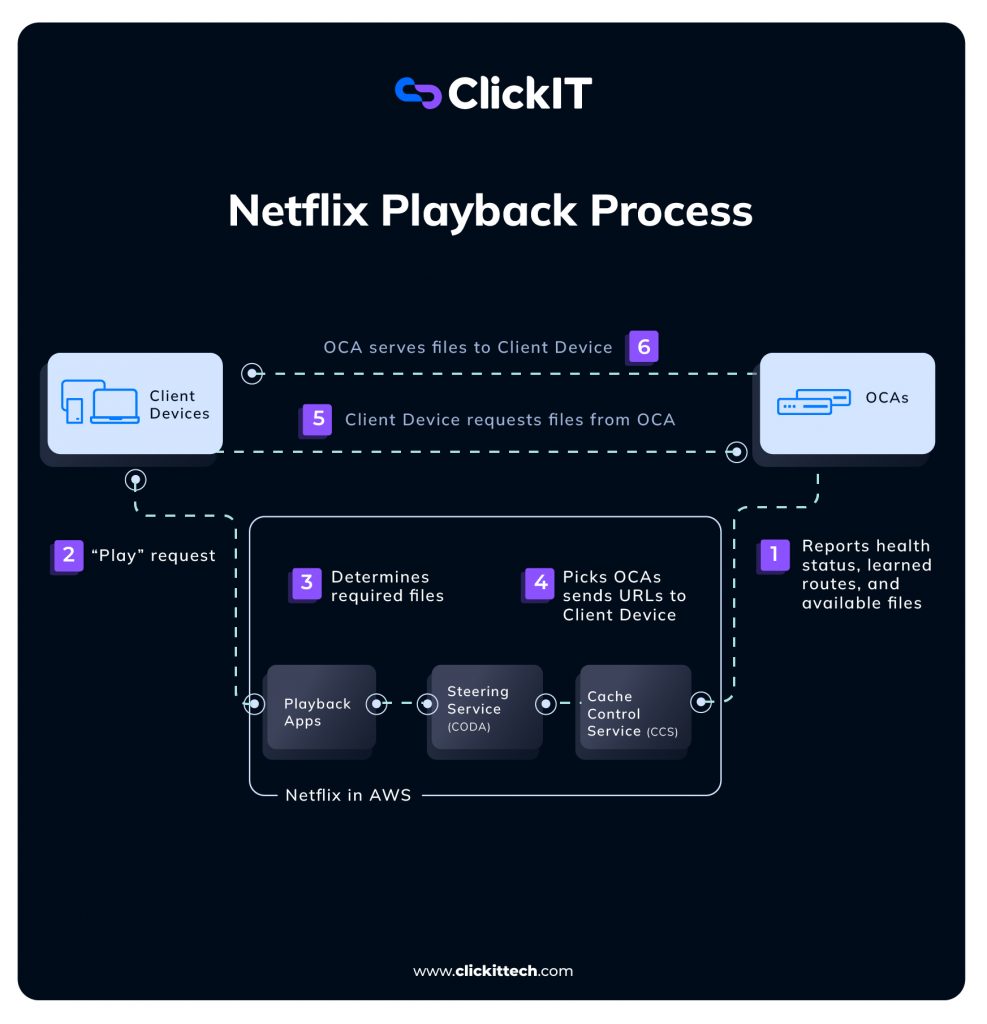
Databases in Netflix Architecture
Leveraging Amazon S3 for Seamless Media Storage
Netflix’s ability to withstand the April 21, 2022, AWS outage demonstrated the value of its cloud infrastructure, particularly its reliance on Amazon S3 for data storage. Netflix’s systems were built to endure such outages by leveraging services like SimpleDB, S3, and Cassandra.
Netflix’s infrastructure is built on the foundation of its use of Amazon S3 (Simple Storage Service) for media storage, which powers the streaming giant’s massive collection of films, TV series, and original content.
Petabytes of data are needed to service millions of Netflix users worldwide, and S3 is the perfect choice for storing this data since it offers scalable, reliable, and highly accessible storage.
Scalability is another important consideration that led Netflix to select S3 for media storage. With S3, Netflix can quickly expand its storage capacity without worrying about adding more hardware or maintaining complicated storage infrastructure as its content collection grows. To meet the growing demand for streaming content without sacrificing user experience or speed, Netflix must be scalable.
In addition, Netflix introduced CockroachDB for globally consistent subscriber and billing metadata beginning in late 2025, enabling reliable ACID transactions across multiple AWS regions.
Entertainment Knowledge Graph
Netflix introduced its Entertainment Knowledge Graph in 2025, an ontology-based platform unifying content, talent, metadata, and creative relationships. This enabled far richer semantic search, talent clustering, similarity analysis, and AI-driven content labeling. It also improved recommendations by feeding structured entity relationships directly into the company’s ranking models.
Embracing NoSQL for Scalability and Flexibility
The need for structured storage access throughout a highly distributed infrastructure drives Netflix’s database selection process. Netflix adopted the paradigm shift towards NoSQL distributed databases after realizing the shortcomings of traditional relational models in the context of Internet-scale operations. Three essential NoSQL solutions stand out in their database ecosystem: Cassandra, Hadoop/HBase, and SimpleDB.
Netflix’s Database Architecture Tools
- Amazon SimpleDB: As Netflix moved to the AWS cloud, SimpleDB from Amazon became an obvious solution for many use cases. It was appealing because of its powerful query capabilities, automatic replication across availability zones, and durability. SimpleDB’s hosted solution reduced operational overhead, which aligns with Netflix’s policy of using cloud providers for non-differentiated operations.
- Apache HBase: Apache HBase evolved as a practical, high-performance solution for Hadoop-based systems. Its dynamic partitioning strategy makes it easier to redistribute load and create clusters, which is crucial for handling Netflix’s growing volume of data. HBase’s robust consistency architecture is enhanced by its support for distributed counters, range queries, and data compression, making it appropriate for various use cases.
- Apache Cassandra: The open-source NoSQL database Cassandra provides performance, scalability, and flexibility. It’s dynamic cluster growth and horizontal scalability meet Netflix’s requirement for unlimited scale. Because of its adaptable consistency, replication mechanisms, and flexible data model, Cassandra is perfect for cross-regional deployments and scaling without single points of failure.
- CockroachDB: Netflix introduced CockroachDB for certain critical data that demands strong consistency (for example, global subscriber plan information). CockroachDB’s distributed SQL capabilities provide transactional guarantees for things like membership plans or codes, while Cassandra continues to serve high-scale workloads where partition tolerance and write throughput are paramount. Using both CockroachDB and Cassandra side by side illustrates Netflix’s pragmatic approach to data: using the right tool for each job in its vast ecosystem.
Since each NoSQL tool is best suited for a particular set of use cases, Netflix has adopted a number of them. While Cassandra excels in cross-regional deployments and fault-tolerant scaling, HBase connects with the Hadoop platform naturally. A learning curve and operational expense accompany a pillar of Netflix’s long-term cloud strategy, NoSQL adoption. Still, the benefits in terms of scalability, availability, and performance make the investment worthwhile.
Across these systems, Netflix’s data engineering teams have implemented a Change Data Capture (CDC) approach to record changes. For instance, Cassandra’s membership data updates are also captured and appended to a Membership History service (backed by Cassandra as an append-only log) so that historical records are retained for analytics and debugging.
This CDC pattern ensures that as Netflix’s customer data changes, nothing is lost and downstream data pipelines can react to real-time events.
MySQL in Netflix’s Billing Infrastructure
Netflix’s billing system experienced a significant transformation due to its extensive migration to AWS cloud-native architecture. Because Netflix relies heavily on billing for its operations, the move to AWS was handled carefully to guarantee that there would be as little impact on members’ experiences as possible and that strict financial standards would be followed.
Tracking billing periods, monitoring payment statuses, and providing data to financial systems for reporting are just a few tasks that Netflix’s billing infrastructure handles. The billing engineering team managed a complicated ecosystem that included batch tasks, APIs, connectors with other services, and data management to accomplish these functionalities.
Database technology selection was one of the most important choices made during the move. MySQL was chosen as the database solution due to scalability and the requirement for ACID transactions in payment processing.
It was a complicated process to migrate to MySQL on AWS; it required careful planning, methodical implementation, and ongoing testing and iteration. Despite the difficulties, the move went well, allowing Netflix to use the scalability and dependability of AWS cloud services for its billing system.
Netflix’s system architecture has updated its billing system and used cloud-based solutions to prepare for upcoming developments in the digital space.
Here is Netflix’s post-migration architecture:

Content Processing Pipeline in Netflix Architecture
In 2025–2026, Netflix enhanced its encoding pipeline with AI-based film grain synthesis using AV1 codec optimizations, achieving 20–30% bandwidth savings while preserving cinematic visual quality.
Netflix also deployed its ML-first “Media Data Lake” architecture using LanceDB, enabling multimodal AI workflows for subtitles, audio quality checks, HDR restoration, and automated similarity search across video and audio embeddings.
The Netflix content processing pipeline is a systematic approach for handling digital assets that partners in content and fulfillment provide. The three main phases are ingestion, transcoding, and packaging.
Ingestion: Source files, such as audio, timed text, or video, are thoroughly examined for accuracy and compliance throughout the ingestion stage. These verifications include semantic signal domain inspections, file format validation, decodability of compressed bitstreams, compliance with Netflix delivery criteria, and data transfer integrity.
Transcoding and Packaging: The sources go through transcoding to produce output elementary streams when they make it beyond the ingestion stage. After that, these streams are encrypted and placed in distribution-ready streamable containers.
Notably, Netflix leverages serverless workflows to scale this processing. For example, when publishers upload new content files to Amazon S3, AWS Lambda functions are triggered to split the video into smaller chunks and encode each chunk in parallel, producing dozens of stream variants efficiently. This serverless approach to video encoding and processing enables Netflix to handle massive content ingestion and encoding tasks rapidly, without managing dedicated encoding server fleets.
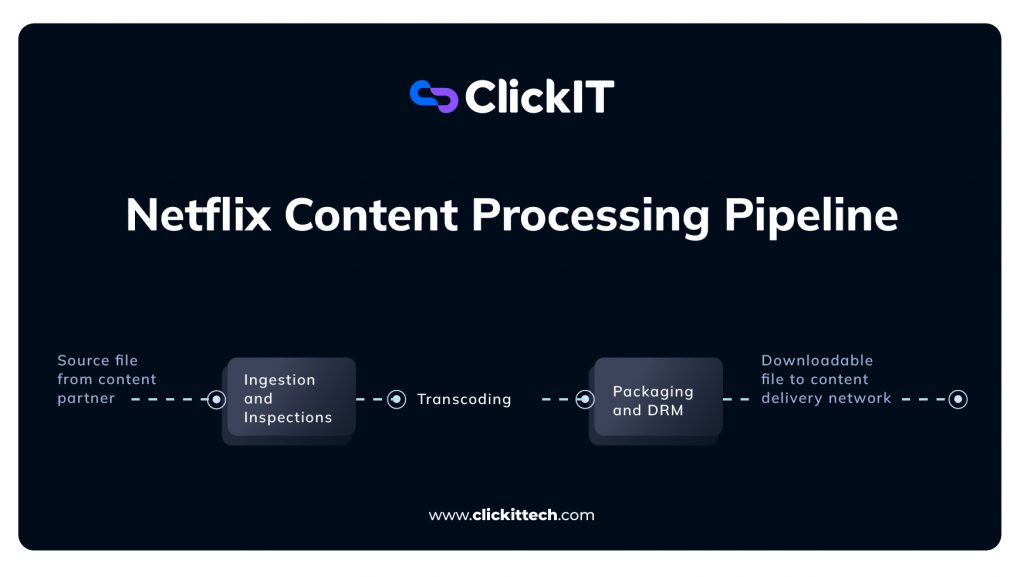
Ensuring Seamless Streaming with Netflix’s Canary Model
Significant money is allocated to guaranteeing thorough evaluation of updated application versions at Netflix system architecture. Nevertheless, thorough internal testing becomes difficult because Netflix is accessible on thousands of devices and is powered by hundreds of independently deployed microservices. As a result, it is crucial to support release decisions with solid field data acquired during the update process.
Netflix’s system architecture has formed a specialized team to mine health signals from the field to expedite the assessment of updated client applications. This system investment increased development velocity, improving application quality and development procedures.
Client Applications
Netflix upgrades its client apps through direct downloads and app store deployments. Distribution control is increased with direct downloads.
Deployment Strategies
Although the advantages of regular, incremental releases for client apps are well known, updating software presents specific difficulties. Since every user’s device delivers data in a stream, efficient signal sampling is crucial.
The deployment strategies employed by Netflix are customized to tackle the distinct challenges posed by a wide range of user devices and complex microservices. The approach differs based on the kind of client—for example, smart TVs vs mobile applications.
New client application versions are progressively made available through staged rollouts, which provide prompt failure handling and intelligent backend service scaling. During rollouts, monitoring client-side error rates and adoption rates guarantees consistency and effectiveness in the deployment procedure.
Staged Rollouts
To reduce risks and scale backend services wisely, staged rollouts entail progressively deploying new software versions.
AB Tests/Client Canaries
Netflix employs an intense variation of A/B testing known as “Client Canaries,” which involves testing complete apps to guarantee timely upgrades within a few hours.
This strategy of rapid, data-driven experimentation allows Netflix to validate new features or performance improvements under real-world conditions. The client canary model, essentially a specialized A/B test, provides Netflix with field data within hours of a new release. Combined with Netflix’s broader A/B testing culture (experimenting with anything from recommendation algorithms to user interface changes), this ensures that decisions about launching features are backed by empirical evidence from actual user interactions.
Orchestration
Orchestration lessens the workload associated with frequent deployments and analysis. It is helpful in managing A/B tests and client canaries.
In summary, millions of customers may enjoy flawless streaming experiences thanks to Netflix’s client canary model, which guarantees frequent app updates.
Beginning in 2025, Netflix began using machine learning to optimize A/B testing and canary deployments. Adaptive causal-inference models reduce experiment duration by up to 40%, allowing faster, data-driven rollouts for UI features, personalization changes, and streaming optimizations.
Netflix System Architecture has revolutionized the entertainment industry. Netflix’s technological infrastructure has been essential to its success throughout its evolution from a DVD rental service to a major worldwide streaming player.
Netflix Architecture, supported by Amazon Web Services (AWS), guarantees uninterrupted streaming for a global user base. Netflix ensures faultless content delivery across devices with its Client, Backend, and Content Delivery Network (CDN).
The innovative usage of HTML5 and personalized suggestions by Netflix System Architecture improves user experience.
Despite some obstacles, Netflix became stronger after switching to a cloud-native setup. In the quickly evolving online entertainment field, Netflix has positioned itself for future development and innovation by embracing microservices, NoSQL databases, and cloud-based solutions. Any tech venture can benefit from understanding Netflix System Architecture
By 2025–2026, the addition of AI-powered search, multi-task foundation models for personalization, advanced encoding with synthetic film grain, and the Entertainment Knowledge Graph further solidified Netflix’s technical leadership in global streaming.
Netflix Architecture FAQs
In addition to using NoSQL databases like Cassandra, HBase, and SimpleDB for flexible and efficient data management, Netflix depends on Amazon S3 for scalable and reliable media storage.
Netflix’s use of HTML5 improves cross-browser and cross-platform compatibility by doing away with the need for plugins such as Silverlight. This action makes content access and playback more fluid, greatly enhancing user experience.
Netflix predominantly relies on Amazon Web Services (AWS) as its cloud provider
To lower latency and enhance streaming quality, the content delivery network (CDN) caches and serves content from servers that are closer to users.
Open Connect is Netflix’s Content Delivery Network (CDN) infrastructure. It is made up of Open Connect Appliances (OCAs), which are strategically placed servers that are spread around several regions in order to minimise latency and provide excellent streaming experiences.
Netflix incorporated generative-AI search, a unified recommendation foundation model, and the Entertainment Knowledge Graph in 2025–2026 to enhance personalization, semantic search, and content discovery across all platforms.




